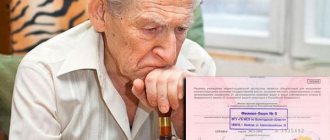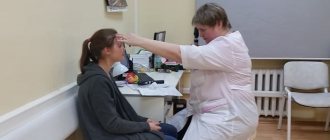Disability due to schizophrenia is a pressing problem in the modern world, since the risk of developing the disease exists in 1% of the population. People who have lost full or partial legal capacity are faced with the problem of providing themselves with food, clothing, and housing. The article explains what kind of support the Russian state provides in this case.
Is it possible to obtain a disability group for this disease?
Is there any disability for schizophrenia? This question worries those who are faced with this disease.
Important! With schizophrenia, disability is not automatically given (based on the presence of the disease). Some patients suffering from this disease are able to work, develop their creativity and even pursue career growth. It is clear that in this case the group “does not threaten” them.
The patient may receive a disability, but one diagnosis is not sufficient to assign a group. During the medical examination, various indicators should be analyzed, namely:
- the patient’s level of self-care ability;
- level of independent movement;
- ability to navigate in space and time;
- level of sociability;
- ability to learn;
- the possibility of working;
- the ability to control one's behavior.
The medical history is collected and recorded by the doctor, who prepares a conclusion for the medical examination. The following sources are used:
- patient complaints;
- characteristics from work or educational institution;
- stories from relatives;
- an extract from the medical history (if there was an examination and/or treatment in a hospital).
Specialists of the ITU commission assess the level of manifestation of symptoms of the disease in the patient and display indicators of his level of vital activity as a percentage.
In what cases is a group given?
A person suffering from schizophrenia may receive a disability, but the presence of a diagnosis is not a sufficient criterion for obtaining a group. During the medical examination, many nuances are taken into account, namely:
- self-care ability;
- frequency and duration of the active phase of the disease;
- level of social adaptation;
- ability to work;
- duration of the disease;
- perception of space and time;
- level of self-control;
- ability to move independently.
Almost half of patients with schizophrenia receive mental disability
As a rule, disability group 2 is established - non-working. In case of a mild course of the disease, accompanied by minor disturbances in mental activity, group 3 is assigned.
Disability group 1 is established in the case of persistent progression of the pathology, in which there is a complete loss of emotional vitality, inactivity, inability to self-care, and incapacity. And also if there are constant hallucinatory-delusional and catatonic states with a complete loss of objective assessment of the surrounding world.
Disability group for schizophrenia. Who is given the group
When a doctor notes a tendency toward increasing progression in a patient, we can talk about the onset of disability. Progression indicates the depth of damage to the psyche.
Doctors distinguish two groups of symptoms in schizophrenia.
Productive (positive) symptoms:
- delirium, persecution mania;
- the patient can hear voices;
- normal brain activity stops;
- the patient may remain in one position for a long time, as if he freezes;
- the patient makes faces and behaves foolishly.
Deficient (negative) symptoms:
- inappropriate unnatural emotions;
- poor speech;
- aimless pastime;
- isolation and even fear of communication.
In order to eliminate as much as possible a subjective attitude towards the patient’s health status, there is a mathematical system for assessing the level of severity of disease symptoms (in percentage).
For episodic, relapsing schizophrenia:
- 2 seizures per year lasting up to 16 weeks; the weakening of the disease is persistent, basic life skills are preserved: manifestation by 10 - 30%.
- 1-2 seizures per year lasting up to 16 or more weeks, symptoms of the disease that appeared earlier are absent, life skills are impaired: manifestation by 40 - 60%.
- Prolonged or frequent seizures with a total duration of 40 weeks to a year, life skills are destroyed: manifestation by 70 - 80%.
For episodic schizophrenia with a stable defect, episodic schizophrenia with an increasing defect; paranoid, hebephrenic, catatonic, undifferentiated, unspecified, residual schizophrenia:
- No more than one seizure per year lasting up to 16 weeks, persistent weakening of the disease with episodes of type 2 symptoms, life skills are not significantly impaired: manifestation by 10 - 30%.
- The duration of the attack is more than 16 weeks, a short weakening of the disease with moderate symptoms of type 2, life skills are impaired: manifestation by 40 - 60%.
- The duration of the attack is more than 24 weeks, a short weakening of the disease with severe symptoms of type 2, no life skills: manifestation is 70 - 80%.
- The duration of the attack is more than 40 weeks with significantly pronounced symptoms of type 2, the need for constant care and examination: manifestation is 90 - 100%.
For continuous paranoid schizophrenia and residual schizophrenia:
- Symptoms of both types 1 and 2, life skills are not significantly impaired, the patient is oriented in society, aware of his disease: manifestation is 20 - 30%.
- Symptoms of type 1 or moderately negative, personality changes are associated with difficulties in communication: manifestation is 40–60%.
- The symptoms are clearly expressed as type 1 and/or type 2, personal changes are clearly observable, the patient is not aware of his illness, is afraid of the company of people: manifestation is 70 - 80%.
- Symptoms are pronounced type 1 and/or type 2, significant personality changes, the need for constant care and supervision: 90 - 100% manifestation
For continuous hebephrenic, catatonic, undifferentiated, residual, simple schizophrenia:
- Rapid development of the disease with a rapid rate of formation of stable signs of the disease, complete inability to communicate: manifestation is 70 - 80%.
- Rapid development of the disease with the formation of stable signs of the disease, with the need for constant care: 90 – 100%.
Schizotypal disorder:
- The disease is progressing, the symptoms are type 1, the patient’s life skills are not significantly impaired, he is oriented in society, he is aware of his disease: manifestation is 10–30%.
- The disease progresses, the symptoms are moderate according to type 1, psychopathological, the patient has difficulty adapting to society: the manifestation is 40 - 60%.
- The disease progresses, the symptoms are persistently expressed in type 1, psychopathological, the patient is not aware of his disease, cannot tolerate the company of people: manifestation is 70 - 80%.
- The disease progresses slowly, pronounced panic moods appear, the patient needs constant care and supervision: manifestation is 90 - 100%.
Mood disorders:
- Minor behavioral disorders that can be successfully treated with medications, the weakening of the disease is stable, the patient does not suffer from the inability to behave in society: manifestation is 10 - 30%.
- Sustained long-term or frequent behavioral deviations, moderately current, lasting more than 24 weeks per year, the patient has difficulty navigating in society: manifestation is 40 - 60%.
- Sustained long-term or frequent behavioral deviations lasting more than 40 weeks per year, the implementation of simple activities is difficult: manifestation is 70 - 80%.
- Persistent long-term or frequent behavioral abnormalities lasting more than 40 weeks per year, requiring constant care and supervision: 90 – 100%.
What disability group can be assigned to a patient with schizophrenia? A group of patients with this diagnosis is assigned to different types of disease. The main criterion is the level of progression, that is, the degree of deepening of the symptoms of the disease.
Group 1 (for a period of 2 years) is given to patients in whom the main symptoms of the disease manifest themselves by 90–100%. These people cannot take care of themselves, they are not aware of themselves in the real world, there are no bright intervals during the course of the disease.
group 2 (for a period of 1 year) is assigned to patients in whom the main symptoms of the disease manifest themselves by 70–80%. The disease develops rapidly, the symptoms become malignant, the patient is often forced to undergo hospital treatment over the course of a year, the improvements are insignificant and imperceptible.
Group 3 (for a period of 1 year) is assigned to patients in whom the main symptoms of the disease manifest themselves by 40–60%. Seizures in patients are rare and, despite the restrictions, they remain able to work.
The category “disabled since childhood” is established if the child exhibits the main symptoms of the disease in the range of 40 – 100%. Disability is established for a period of 1 year, 2 years, 5 years or until the child reaches adulthood.
Which group is given in the presence of persistent schizophrenia?
The degree of disability, which is established taking into account the patient’s lifestyle, his ability to behave in society, directly affects the group assigned to him. Let's consider the ratios:
- The third group is appointed at the first degree of restriction for a period of two years. It is characterized by rare and unstable periods of remission. Symptoms appear at 40-60%. The patient's performance remains intact.
- The second group corresponds to the second degree (the most common stage) with a period of 1 year. With it, a malignant course is observed, cases of hospitalization become more frequent and periods of remission are reduced. Symptoms manifest themselves in 70-80%.
- The first group may occur with a third degree of limitation. She is appointed for 1 year. A persistent, hopeless disorder with detachment from reality is observed. Most often, this condition occurs in patients with canonical schizophrenia. Symptoms appear 90-100%.
The refusal of the EMS can be appealed by the patient himself, his close people in administrative (complaint to the EMS bureau) and judicial procedure (claim in the court of general instance). To resolve the dispute, an independent examination can be appointed, which will allow the true picture to be reproduced.
A number of documents to obtain a group
To receive disability for schizophrenia, the patient must come to the ITU institution with:
- application for conducting ITU;
- passport and copy of passport data;
- a photocopy of the work book (if available);
- sometimes - a certificate of income;
- hospital card;
- available hospital records and their copies;
- written reference from work or school.
What documents are needed to register disability?
If the patient’s condition is so bad that it is necessary to register a disability, the doctor writes a referral to medical examination. This is a medical commission that assigns a disability group. In order to pass it, you need to provide a number of documents:
- Application from the patient or referral from the doctor;
- Passport and its copy;
- Medical documents - extracts from medical records, copies of sick leave certificates, examination results;
- Working documents - a copy of the work book, a reference from the manager;
- Additional documents - income certificate, neighbors' certificates - are not required.
The child comes to the commission with his parents or guardian, who must also have passports and documents confirming the right of guardianship. Is disability for schizophrenia granted to adults who have already been declared incompetent before? They do, and to do this you need to come to the commission together with a relative who has been given custody of the patient.
Procedure for obtaining a group
Sequence of actions to obtain a disability group for schizophrenia:
- Visiting your local doctor.
- Visiting medical specialists as directed by your local doctor.
- Passing examination in a hospital.
- To receive a referral for medical examination, for this you need to undergo a commission with doctors at the clinic.
- Contacting ITU specialists to set the time for the examination.
- ITU Commission.
- If disability is recognized, the patient receives a certificate of disability and an individual rehabilitation program (IRP).
- With a certificate of assigned disability, you need to come to the Pension Fund (or MFC) to assign a pension, in addition, you need to contact social protection in order to receive state benefits.
Important! After the period established for disability expires, a re-examination of the sick person - a disabled person - must be carried out.
Examination for schizophrenia
The establishment of incapacity for work and disability in schizophrenia is carried out after a medical and social examination. As a rule, disability is determined during the period of remission, when the severity of negative symptoms decreases. In the case of a prolonged exacerbation of the disease or during a continuous process, the examination is carried out less frequently.
It is important to take into account that in some cases the quality of remission may deteriorate under the influence of various negative factors not related to the activity of the pathological process. At the time of disability, clinical manifestations have their own characteristics, depending on the form and course of the disease. They reflect the tendency of the disease towards increasing progression.
Pension for disability due to schizophrenia
The schizophrenia pension is issued to disabled people of groups 1, 2 and 3, and to disabled people since childhood. The size of such a social pension is determined depending on the disability group:
- for 1 g. – 10068.53 rub./month;
- disabled people from childhood 1 gr. – 12082.06 rub./month;
- for 2 gr. – 5034.25 rub./month;
- disabled people from childhood 2 gr. – 10068.53 rub./month;
- for 3 gr. – 4279.14 rub./month.
Also, in accordance with the legislation of the Russian Federation, the following amounts of monthly cash payment (MAP) are determined:
- for 1 g. – 3538.52 rubles/month;
- for 2 gr. – 2527.06 rub./month;
- for 3 gr. – 2022.94 rubles/month;
- disabled people since childhood – 2527.06 rubles/month.
Thus, the pension consists of the pension indicator, depending on the disability group, and the monthly allowance for the same group.
The general scheme for obtaining disability for various diseases, including mental disorders, is described in this video
So, for schizophrenia they give disability! Depending on the degree of damage, the patient is assigned a certain disability group and is paid an appropriate pension. To do this, the patient, with the help of relatives, needs to collect a number of documents and correctly go through the entire procedure for entering the group.
Where to start applying for disability due to mental illness
When registering a disability group, the doctor takes into account the patient’s complaints and his medical history, which contains data on hospitalizations, treatment, and the effect obtained. Based on them, a conclusion is drawn about the patient’s condition and the need to collect documents for disability.
Depending on the patient’s behavior, a number of forms of schizophrenia are distinguished:
| Form | Productive symptoms | Deficient symptoms | Exacerbation frequency | Progression | Social maladjustment |
| Paranoid | Delusions of persecution, suggestion; Pseudohallucinations (voices in the head), most often demanding to do something; Delusions of Grandeur (optional) | Weakly expressed. Aggressiveness, suspiciousness, irritability | 1-2 times a year | Depends on the frequency of exacerbations | Pronounced, social connections are quickly destroyed |
| Catatonic | Weakly expressed. Possible auditory pseudohallucinations | Decreased physical activity and motivation | Up to once a year, becoming more frequent as it progresses | Slow | Insignificant in the early stages, intensifies as it progresses |
| Hebephrenic | Delusional ideas of various contents, hallucinations | Goofiness, inappropriate gaiety, loss of empathy | 1-2 times a year | Fast | Social skills are lost quickly |
| Undifferentiated | Symptoms inherent in various forms of the disease | Varies | |||
| Residual | Absent | Weakly expressed | Happened once in the past | Not progressing | Fully saved |
For minors, only the rate of progression and frequency of attacks matter, and symptoms change significantly with age. As you grow older, the degree of maladjustment may change sharply (usually towards deterioration, but recovery options are possible). For children, separate disability groups are not distinguished, but one general one is awarded - childhood disability, which requires re-examination after a year, and if stable, remains until adulthood.
Benefits for disabled people with schizophrenia
The amount of social security that determines disability for schizophrenia depends on the assigned group. The pension in 2021 has been increased to the following levels:
- Group 1 disability since childhood – 12,432.44 rubles.
- Group 1 and disabled childhood group 2 – 10,360.52 rubles.
- 3 category – 4403.24 rubles.
Current figures will be revised April 1, 2021 - 2020.
From February 2021, the following EDV indicators are in effect:
- Disabled children – 2804.28 rubles.
- Group 3 – 2244.85 rubles.
- Group 2 – 2804.28 rubles.
- 1st group – 3926.28 rubles.
Schizophrenia also provides grounds for other benefits, which are determined by the corresponding disability group. This includes free travel + social medications, health improvement, increased stipends, and a shortened working week.










